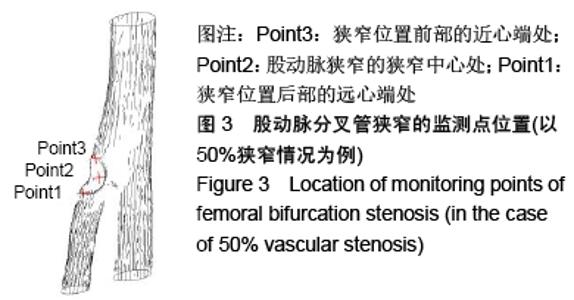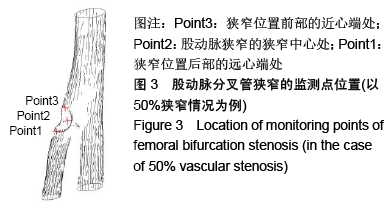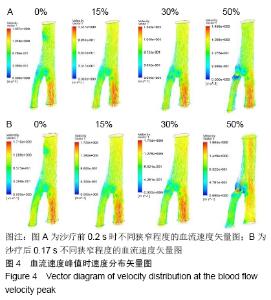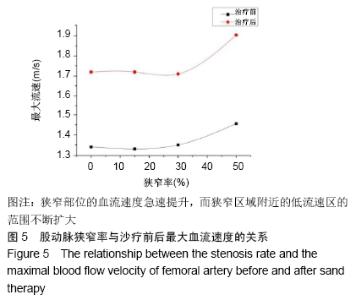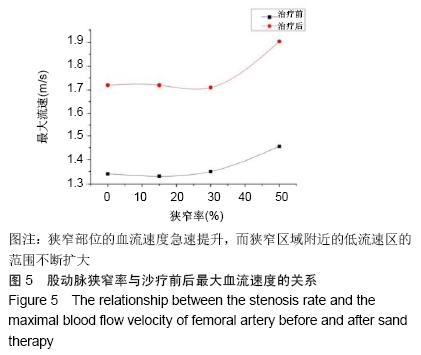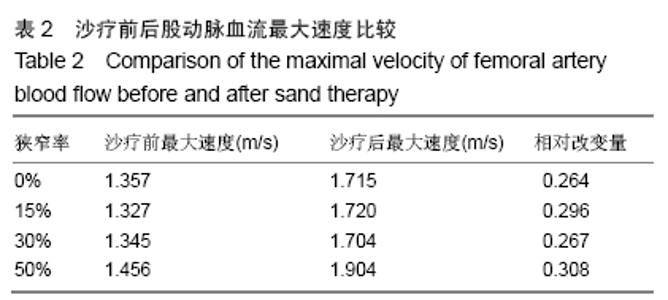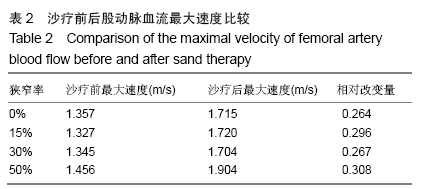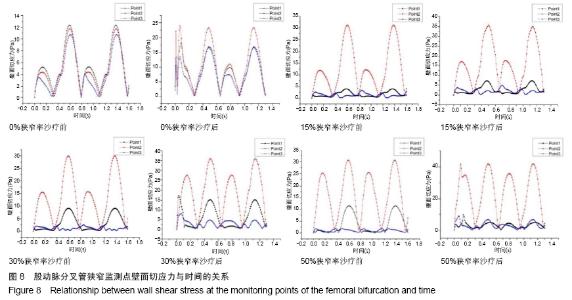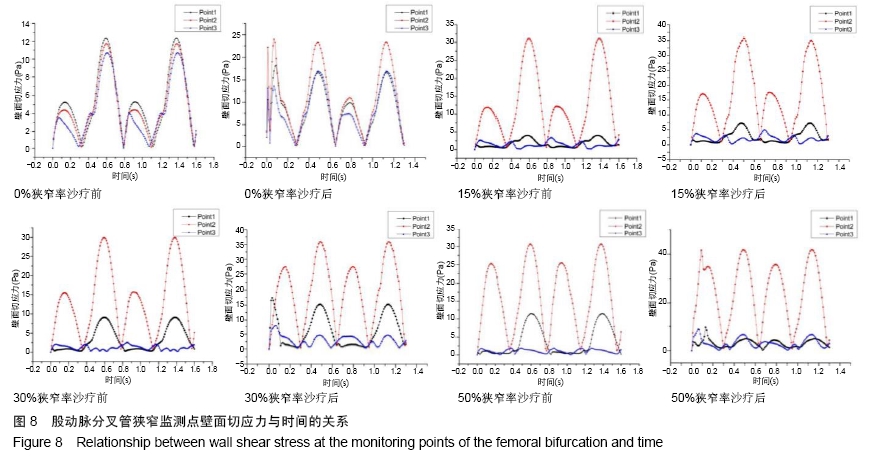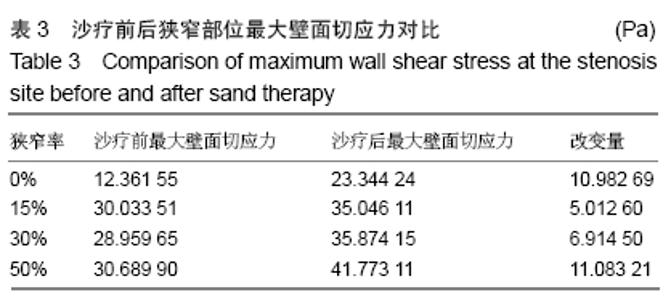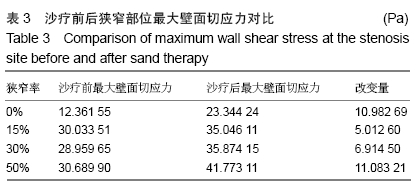Chinese Journal of Tissue Engineering Research ›› 2020, Vol. 24 ›› Issue (8): 1218-1224.doi: 10.3969/j.issn.2095-4344.1882
Previous Articles Next Articles
Effects of sand therapy on hemodynamics in the femoral artery bifurcation at different degrees of stenosis
Qiao Yuqi, Fu Rongchang, Zhang Lihong
- School of Mechanical Engineering, Xinjiang University, Urumqi 830047, Xinjiang Uygur Autonomous Region, China
-
Received:2019-04-19Revised:2019-05-06Accepted:2019-06-15Online:2020-03-18Published:2020-01-22 -
Contact:Fu Rongchang, Master, Associate professor, School of Mechanical Engineering, Xinjiang University, Urumqi 830047, Xinjiang Uygur Autonomous Region, China -
About author:Qiao Yuqi, Master candidate,School of Mechanical Engineering, Xinjiang University, Urumqi 830047, Xinjiang Uygur Autonomous Region, China -
Supported by:the National Natural Science Foundation of China, No. 31460245
CLC Number:
Cite this article
Qiao Yuqi, Fu Rongchang, Zhang Lihong. Effects of sand therapy on hemodynamics in the femoral artery bifurcation at different degrees of stenosis[J]. Chinese Journal of Tissue Engineering Research, 2020, 24(8): 1218-1224.
share this article
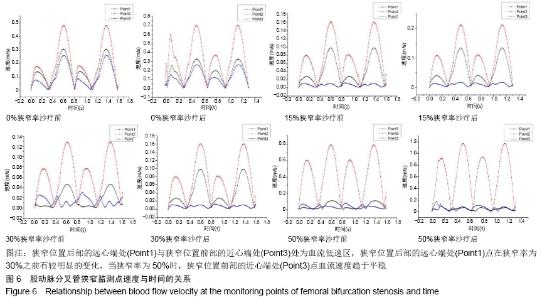
2.2.4 监测点狭窄位置后部的远心端处(Point1)、股动脉狭窄的狭窄中心处(Point2)、狭窄位置前部的近心端处(Point3)处的血流速度与时间的关系 见图6。得到血流收缩加速期0.04 s、心动收缩峰值期0.14 s、心动收缩减速末期0.34 s、心动舒张峰值期0.59 s、舒张末期0.79 s时的血流速度,此计算结果与人体实际的心动周期具体时间阶段相符合[25-26]。比较股动脉分叉管狭窄一侧3个监测点的血流速度,相比于正常血管,不同程度狭窄的血管监测点位置的血流速度参数有较明显的差别。沙疗后股动脉狭窄的狭窄中心处(Point2)点处的血流峰值在狭窄率达到30%之前比沙疗前平均增长了0.04 m/s,在狭窄程度为50%时比沙疗前增长了0.2 m/s。狭窄位置后部的远心端处(Point1)与狭窄位置前部的近心端处(Point3)处为血流低速区,两者相比较,狭窄位置前部的近心端处(Point3)点处的血液流动速度较平稳,狭窄位置后部的远心端处(Point1)点在狭窄率为30%之前有较明显的变化,当狭窄率为50%时,狭窄位置前部的近心端处(Point3)点血流速度趋于平稳。 "
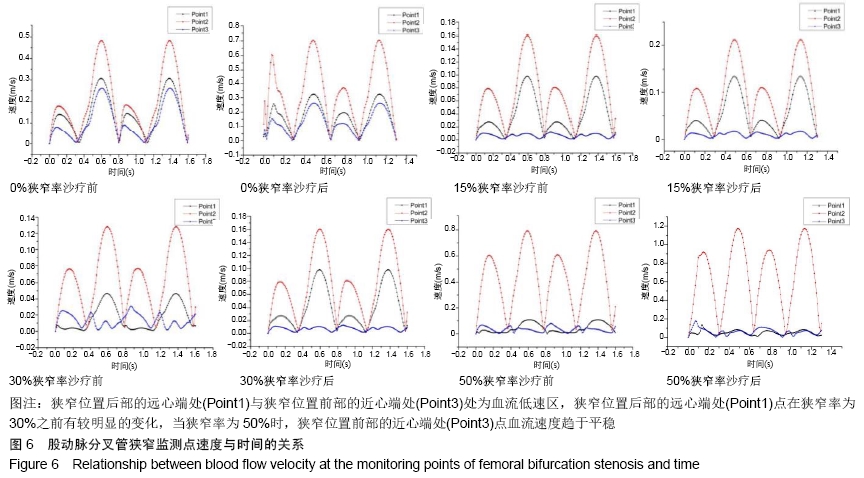

2.3 壁面切应力(WSS) 2.3.1 股动脉壁面切应力分布 见图7。股动脉分叉管中壁面切应力产生明显变化的部位分布在股动脉分支的分叉脊部位以及动脉狭窄部位。沙疗前高壁面切应力区产生在分叉对侧的狭窄部位,狭窄部位前部的近心端区域壁面切应力减小,狭窄部位后部的远心端区域产生低壁面切应力区,并随着狭窄程度的不断扩大,低壁面切应力区域也不断扩大。与此同时,股动脉分叉管部位的壁面切应力也随着狭窄程度的不断扩大而增大。沙疗后低壁面切应力区域仍然位于股动脉分叉管侧狭窄部位,但狭窄部位周围的低壁面切应力区域随着狭窄程度的扩大不断减小,且股动脉分叉管部位的高壁面切应力区域有所减弱。通过对比沙疗前后同种狭窄程度的壁面切应力分布云图,最大壁面切应力不断增大,而最小壁面切应力也不断增加。 "

| [1] 刘龙,迪丽娜尔•马合木提,富荣昌,等.室内沙疗对人体股动脉血流动力学影响的实验研究[J].新疆医科大学学报, 2014,37(1): 29-31. [2] 布热比•依明,富荣昌,阿达依•谢尔亚孜旦,等.维医沙疗对股动脉分叉的血流动力学影响[J].医用生物力学杂志,2016,31(5): 431-436. [3] 布热比•依明,富荣昌,维医沙疗下股动脉双向流固耦合血流动力学数值模拟[J].中国生物医学工程学报,2017,36(4): 507-511. [4] 王克强,杨俊华,吴国强,等.腹主动脉分叉处粥样斑块分布及其意义[J].上海医科大学学报, 1989,16(6):427-430. [5] 李珊. 冠状动脉分叉病变斑块分布特点研究——多排螺旋CT和血管内超声分析[D].北京:中国人民解放军军医进修学院.2007. [6] GAO H, LONG Q, KUMAR DAS S,et al.Study of carotid arterial plaque stress for symptomatic and asymptomatic patients.J Biomech. 2011;44(14):2551-2557. [7] KRISHNAN B.CHANDRAN, STANLEY E.RITTGERS, AJIT P. Yoganathan. Biofluid Mechanics-The Human Circulation. CRC Press.2012. [8] 鲍觅夏,周平,郭凤,等.过载负荷下分叉血管的流动数值模拟[J].中国组织工程研究,2019,23(4):551-555. [9] DERBEL H, KOBEITER H, PIZAINE G, et al.Accuracy of a Cone-Beam CT Virtual Parenchymal Perfusion Algorithm for Liver Cancer Targeting during Intra-arterial Therapy. J Vasc Interv Radiol. 2018;29(2):254-261.e2. [10] 张梅,张运,高月花.颈动脉及股动脉内膜-中膜层厚度正常值的对比研究[J].中国医学影像技术,2002,18(1):32-33. [11] 章德发,刘莹,毕勇强,等.不同狭窄率的颈动脉内血流动力学数值模拟[J].中国老年学杂志,2015,35(7):1872-1875. [12] 杨文慧,何燕,魏云鸿,等.超声检测颈动脉粥样硬化对冠心病的预测价值[J].中华老年心脑血管病杂志,2014;16(8) :880-882. [13] 杨眉.下肢动脉斑块形成所致血管狭窄的彩超诊断及分析[J].双足与保健,2018,27(2):131+133. [14] 戴正行,居敏昊,王婷,等.MSCTA不同图像后处理技术诊断常见下肢动脉病变的准确性观察[J].中国CT和MRI杂志,2017,15(8): 149-152. [15] 冯元桢.生物力学[M] .北京:科学出版社,1983. [16] 邓小燕,孙安强,刘肖,等.生物流体力学[M].北京:机械工业出版社, 2014. [17] 王勖成.有限单元法[M].北京:清华大学出版社,2003. [18] LIU GY, WU JH, GHISTA DN, et al. Hemodynamic characterizationof transient blood flow in right coronary arteries with varying curvature and side-branch bifurcation angles. Comput Biol Med.2015;64:117-126. [19] 豆中强.动脉血管中脉动血流的数值模拟[D].重庆:重庆大学, 2006. [20] XU P, LIU X, SONG Q, et al.Patient-specific structural effects on hemodynamics in the ischemic lower limb artery. Sci Rep. 2016;6:39225. [21] COSTAS CH, STANLEY AB. Fully developed pulsatile flow in a curved pipe.J Fluid Mech.2011;195:23. [22] CHAICHANA T, SUN Z, JEWKES J. Computation of hemodynamics in the left coronary artery with variable angulations.J Biomech. 2011;44(10):1869-1878. [23] SHAHCHERAGHI N,DWYER HA,CHEER AY,et al. Unsteady and three-dimensional simulation of blood flow in the human aortic arch.J Biomech Eng. 2002;124(4):378-87. [24] LIU JY, CHEN CC, WANG WH, et al.Comparison of blood flow dynamics in thoracic aortic dissection and normal aortic based on CT images.BME Clin Med.2010;14(5):390-393. [25] 刘莹,章德发,殷艳飞,等.颈动脉双向流固耦合模型非稳态血流数值分析[J].介入放射学杂志,2015,24(10):885-889. [26] CAN Y, KILIÇ H, AKSOY M,et al. OP-204 [AJC » Interventions for peripheral arterial diseases] Endovascular Treatment of Arteriovenous Fistula. The American Journal of Cardiology. 2017;23-26:e64. [27] LANGE U, MÜLLER-LADNER U, SCHMIDT KL. Balneotherapy in rheumatic diseases–an overview of novel and known aspects. Rheumatology International. 2006;26(6):497-499. [28] ZUNNUNOV ZR, MAMATMURADOV SO.Hemodynamics in patients with hypertension after ammotherapy.Vopr Kurortol Fizioter Lech Fiz Kult. 2004;(3):13-15. [29] 尼加提•外力,居来提•买提肉孜,李艳娜,等.沙疗温度对骨重建实验的影响及传热数值模拟研究[J].中国实验动物学报,2017, 25(2):181-185 [30] 王小龙,陈弼沧,吴秋英.维吾尔医学埋沙疗法治疗骨关节炎研究现状[J].光明中医,2015,30(6):1374-1375. [31] CHEN H, LI Z, HONG H, et al.Relationship between visible branch arteries distal to the stenosis on magnetic resonance angiography and stroke recurrence in patients with severe middle cerebral artery trunk stenosis: a one-year follow up study.BMC Neurol. 2015;15:167. [32] 于洁,高传玉,许文克,等.超声检查和血管造影对兔动脉粥样硬化狭窄模型的评价[J].中国临床康复,2006,10(40):51-53+193. [33] MATSAGKAS M, KOUVELOS G, ARNAOUTOGLOU E,et al. Hybrid Procedures for Patients With Critical Limb Ischemia and Severe Common Femoral Artery Atherosclerosis.Ann Vasc Surg. 2011;25(8):1063-1069. [34] SHAALAN WE, FRENCH-SHERRY E, CASTILLA M, et al. Reliability of common femoral artery hemodynamics in assessing the severity of aortoiliac inflow disease.J Vasc Surg. 2003;37(5):960-969. [35] XU P, LIU X, SONG Q, et al. Patient-specific structural effects on hemodynamics in the ischemic lower limb artery. Sci Rep. 2016;6:39225. [36] 陈玲婷,王荩,彭飞,等.下肢动脉硬化性闭塞症发病机制的研究进展[J].心理月刊,2018(12):111. [37] 王慧琴,王思博,刘亢丁,等.局部血液动力学对颈动脉粥样硬化斑块的影响[J].中风与神经疾病杂志,2017,34(7):667-669. [38] BAKSI AJ, DAVIES JE, HADJILOIZOU N, et al. Attenuation of reflected waves in man during retrograde propagation from femoral artery to proximal aorta. Int J Cardiol. 2016;202: 441-445. [39] HODGES GJ, STEWART DG, DAVISON PJ, et al. The role of shear stress on cutaneous microvascular endothelial function in humans. Eur J Appl Physiol. 2017;117(12):2457-2468. [40] THIM T,HAGENSEN MK,HORLYCK A,et al.Wall shear stress and local plaque development in stenosed carotid arteries of hypercholesterolemic minipigs.J Cardiovasc Dis Res. 2012; 3(2):77. |
| [1] | Bao Mixia, Zhou Ping, Guo Feng, Wang Jia. Numerical simulation of bifurcating blood vessel flow under overload [J]. Chinese Journal of Tissue Engineering Research, 2019, 23(4): 551-555. |
| [2] | Chen Yili1, Lao Yonghua2, Zhang Shaoqun1, Wu Baofeng3, Li Yikai1 . Hydrodynamic model of carotid artery atherosclerosis: hemodynamic changes of carotid atherosclerotic plaques under cervical rotatory manipulation [J]. Chinese Journal of Tissue Engineering Research, 2019, 23(15): 2403-2308. |
| [3] | Hu Wanqian, Li Xuemin, Xu Lin, Liu Jiwei, Sun Hao. Effects of flow rate and blade outlet width on hemolytic performance of centrifugal blood pump [J]. Chinese Journal of Tissue Engineering Research, 2019, 23(10): 1581-1587. |
| [4] | Liu Xia, Wang Wen-juan, Wu Xue-mei, Xie Hong. Effect of target controlled infusion of propofol on perioperative hemodynamics and awakening period in elderly patients [J]. Chinese Journal of Tissue Engineering Research, 2018, 22(30): 4835-4840. |
| [5] | Tang Dan, Yuan Quan, Wang Zhi-chao, Zhu Hong-wei . Hemodynamic analysis of coronary stents in curved vessels [J]. Chinese Journal of Tissue Engineering Research, 2018, 22(22): 3563-3568. |
| [6] |
Zhang Ye-peng, Zhou Min, Tang Wen-hao.
Numerical simulation of hemodynamics in a bioresorbable vascular scaffold
[J]. Chinese Journal of Tissue Engineering Research, 2017, 21(34): 5532-5537.
|
| [7] |
Liu Xiao-yue, Muhetaer Kelimu, Ju Gang, Wang Chen, Li Hui, Sun Hai-xia.
Blood flow field characteristics of cerebral aneurysm before stent implantation
[J]. Chinese Journal of Tissue Engineering Research, 2016, 20(38): 5722-5729.
|
| [8] | Song Yan-feng, Cao Jie. Transplantation of basic fibroblast growth factor-transfected bone marrow mesenchymal stem cells in the treatment of pulmonary hypertension [J]. Chinese Journal of Tissue Engineering Research, 2015, 19(6): 918-922. |
| [9] | Xu Ying. Umbilical cord blood mesenchymal stem cells carrying human telomerase reverse transcriptase for pulmonary arterial hypertension [J]. Chinese Journal of Tissue Engineering Research, 2015, 19(6): 923-927. |
| [10] | Lv Zhi-wei. Effects of aerobic exercise and bone marrow stem cells mobilization on hemodynamics and electrocardiogram of myocardial infarction rats [J]. Chinese Journal of Tissue Engineering Research, 2015, 19(19): 2959-2964. |
| [11] | Ding Hao, Lan Hai-lian, Shang Kun . A research on the shear stress for “myocardial bridge-coronary artery” analog device [J]. Chinese Journal of Tissue Engineering Research, 2014, 18(7): 1033-1038. |
| [12] | Yuan Wei, Chen Zhong-li. Numerical simulation of hemodynamics in the carotid artery [J]. Chinese Journal of Tissue Engineering Research, 2014, 18(42): 6784-6788. |
| [13] | Shen Mei-hua, Alimujiang Abulaiti, Aihemaitijiang Yushufu, Dong Jian, Wang Wei, Liu Ya-fei. Thoracic dorsal artery perforating flap transplantation under high-frequency ultrasound guidance [J]. Chinese Journal of Tissue Engineering Research, 2014, 18(38): 6141-6145. |
| [14] | Fan Xin-na, Zhang Jing, Cai Li-li, Yang Gui-feng, Fu Xiang-hua. Effect of recombinant human B-type natriuretic peptide on renal hemodynamics in a bioengineering model of acute myocardial infarction with heart failure [J]. Chinese Journal of Tissue Engineering Research, 2014, 18(27): 4265-4270. |
| [15] | Lv Shao-mao, Zhong Hua, Chen Li-jun, Duan Shao-yin. Blood flow simulation of internal carotid artery aneurysm using two-way flow-solid coupling method [J]. Chinese Journal of Tissue Engineering Research, 2014, 18(2): 218-224. |
| Viewed | ||||||
|
Full text |
|
|||||
|
Abstract |
|
|||||
